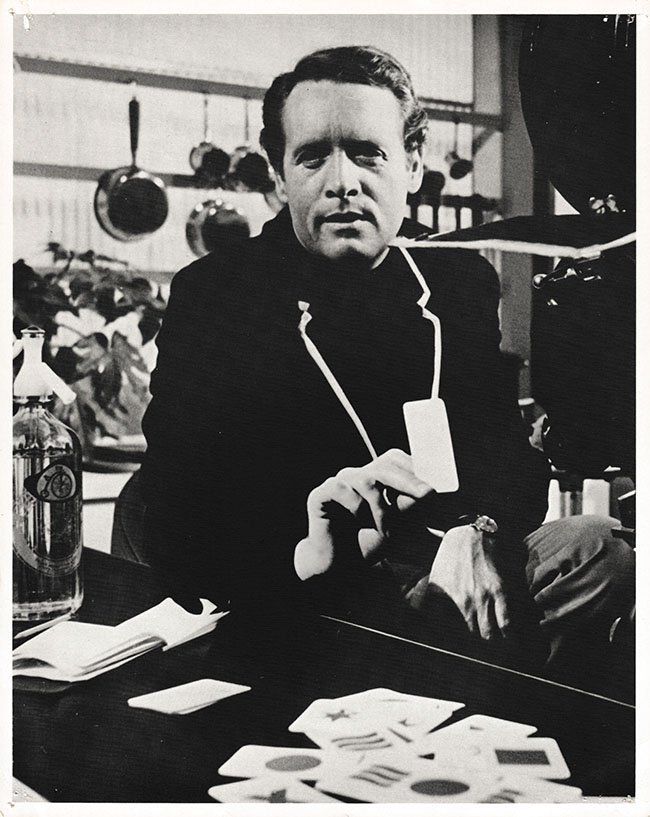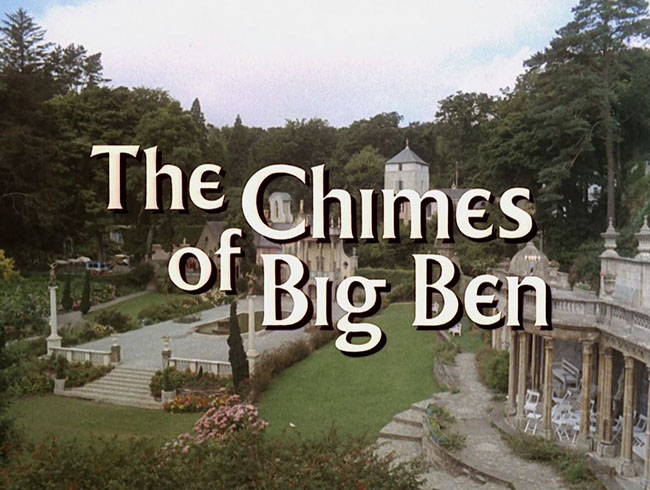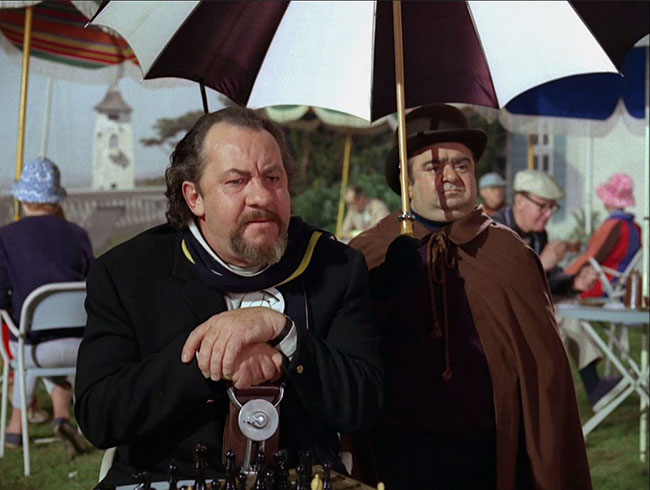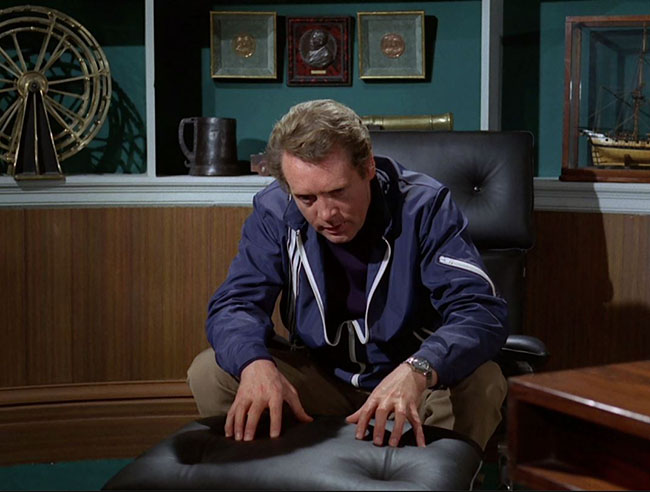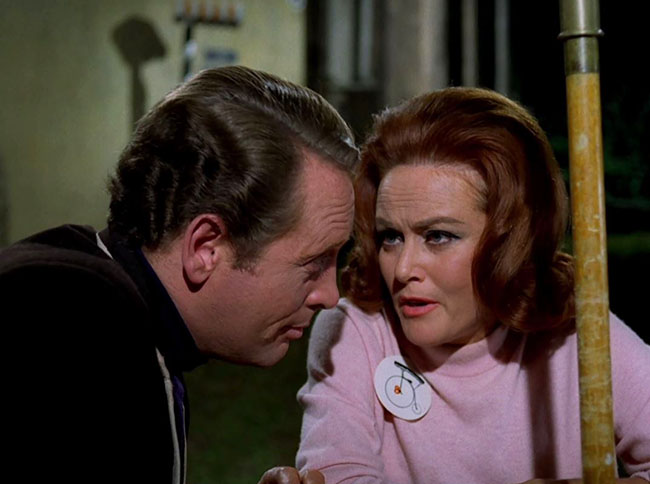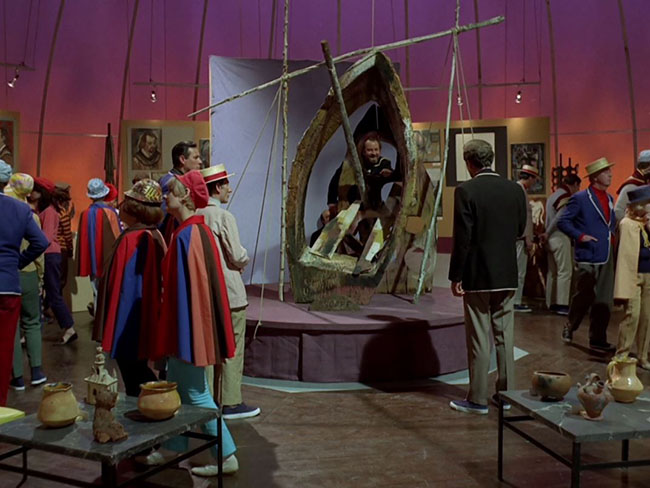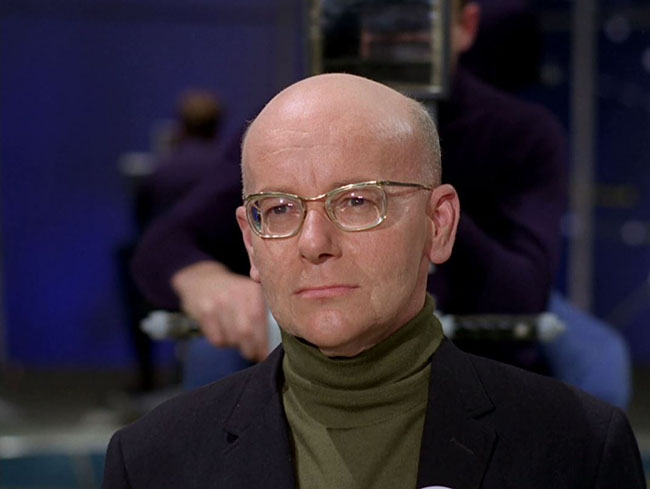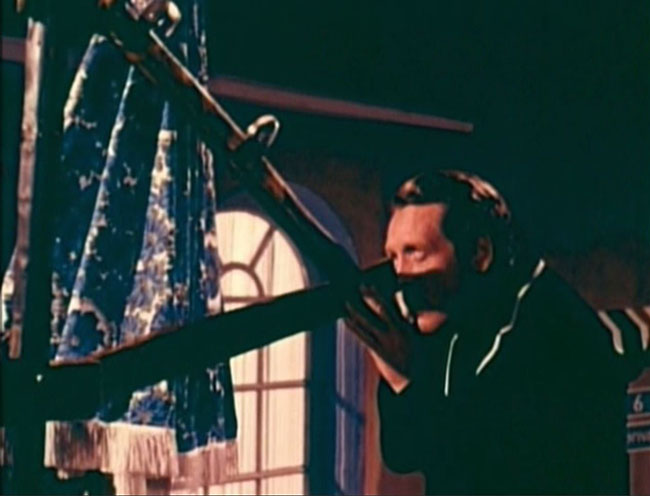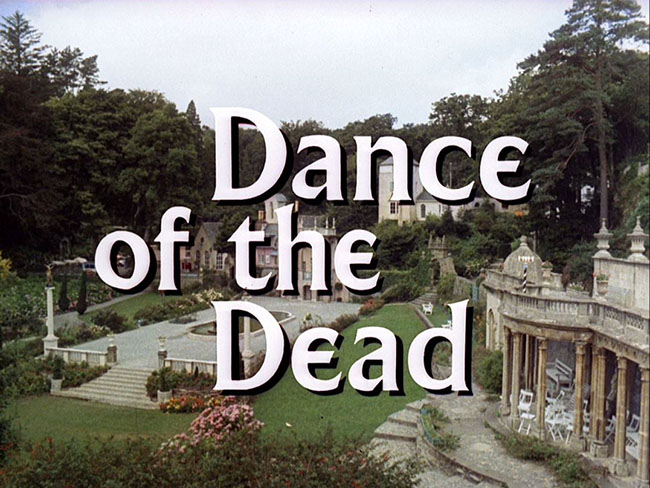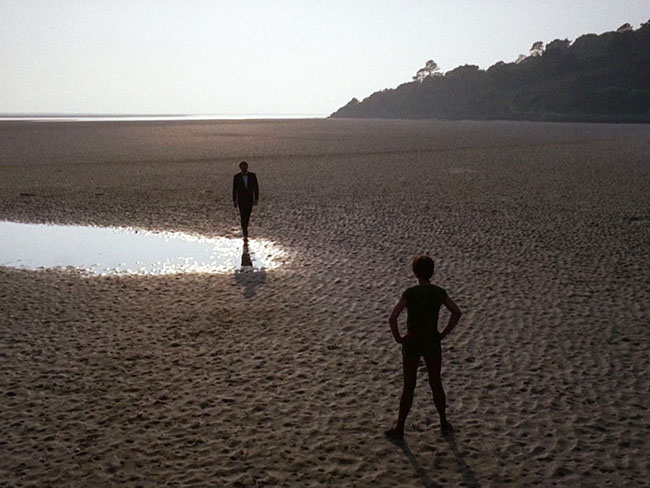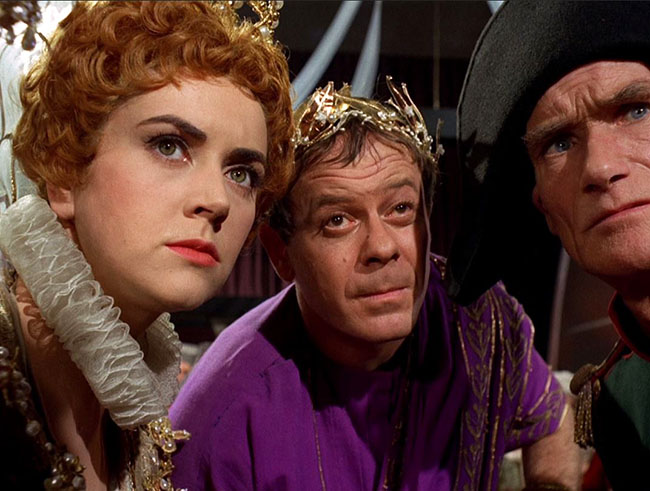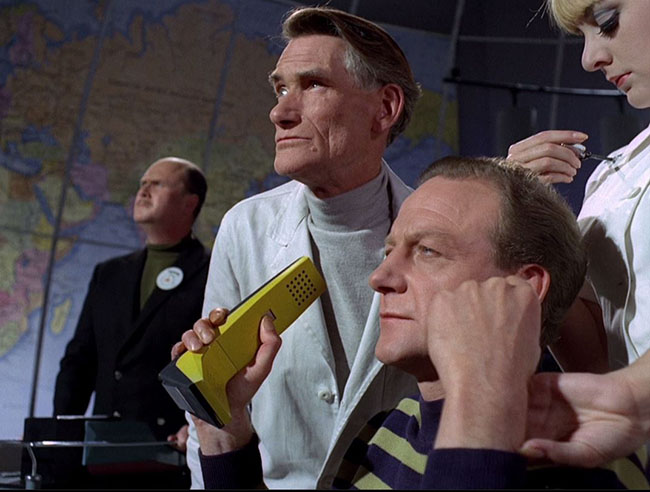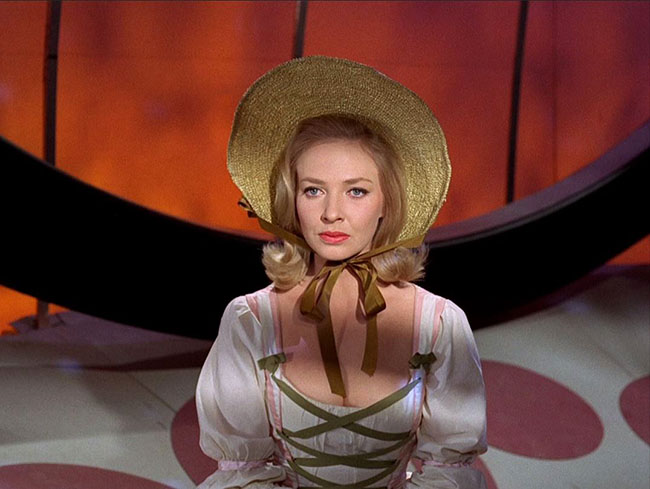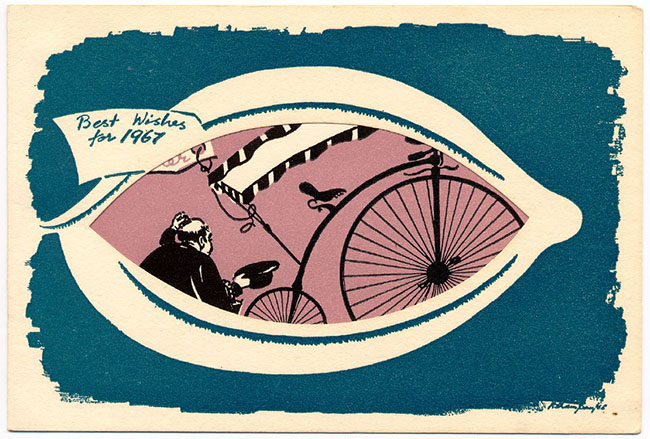THE SCHIZOID MAN First UK Broadcast: October 27, 1967 [episode #5 in transmission order] | Written by Terence Feely | Directed by Pat Jackson
SYNOPSIS
No.6 is helping No. 24 (Jane Merrow, Hands of the Ripper) practice her mind-reading skills for an act in an upcoming Village festival when he accidentally knocks over a bottle, stubbing his finger and leaving a bruise on his fingernail. That night, the new No.2 (Anton Rodgers) has No.6 hypnotized with the rigged, flashing lamp that hovers over his bed. No.6 is given over to the care of a doctor who begins a cruel conditioning treatment. When he awakens, the calendar reads the same day (Wed. Feb. 10), but he has grown a mustache. No.2 phones him up and calls him No.12, inviting him over. As No.6 walks to the Green Dome, a passing Villager also refers to him as No.12, to his confusion. When he meets up with No.2, he’s led to believe that he’s just arrived in the Village to confront No.6 as his doppelgänger and disrupt his sense of identity. He’s given the password of “Gemini” so No.2 can tell them apart. Then 6’s double walks through the door – another No.6 (McGoohan again, usually by a split screen), this one wearing a white jacket instead of black. No.6 tries to prove he’s the genuine article through a series of competitions. At the Recreation Hall, he measures his pistol shooting skills against the false No.6, then fences him. But he finds that he now favors his left hand instead of his right, and the false 6 bests him every time. Back in the Green Dome, No.2 offers a computerized fingerprint test to prove the real No.6, but 6 instead asks to summon No.24 to demonstrate that he still has a genuine mental bond with her. During the mind reading game, however, she fails to read any of No.6’s cards, instead matching with the double. Worst of all, the double has a tell-tale mole on his wrist, and No.6 doesn’t.
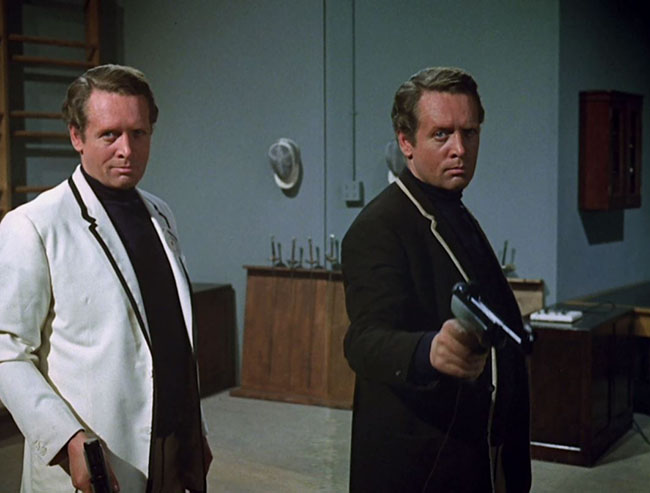
No.12 and No.6 match their skills at pistols – but which is which?
No.6 returns to his residence desperate and unbalanced. It’s only when he notices that the bruise on his fingernail has migrated upward from fingernail growth that he realizes it isn’t truly February the 10th. Memories return to him in a flash – of the conditioning which taught him to be left-handed and gave him instincts and tastes belonging to someone else. He relearns his right-handedness by exposing his left hand to a dangerous electric charge. Then he goes to find No.12, currently living at his own house, and pretends to be unraveled, suggesting that he’s about to give up why he resigned. He takes No.12 off guard and defeats him, learning his name, Curtis, and the real password: “The Schizoid Man.” Outside the residence, Rover approaches both of them, but can’t tell which is which. They both give the password “The Schizoid Man” – and Rover chooses to consume Curtis. No.6 returns to the Green Dome, pretending to be his double. No.2 is beside himself that the Village’s most important subject has been killed. He asks that he go speak to No.24, whose real name is Alison, to gather further insight on No.6 before he leaves. She seems to recognize that he isn’t really Curtis, and when he’s heading toward a helicopter to depart the Village, she tells him candidly that if she had another chance, she wouldn’t do what she did: “It was a betrayal.” But No.2 has noticed “Curtis” saying odd things which the real Curtis would never say, and as 6 boards the helicopter, 2 asks him to give Curtis’s wife, Susan, his regards. 6 says he will. Then he’s blindfolded and taken up into the air, only to be brought straight down again. His blindfold is removed, and No.2 says, “Susan died a year ago, No.6.”
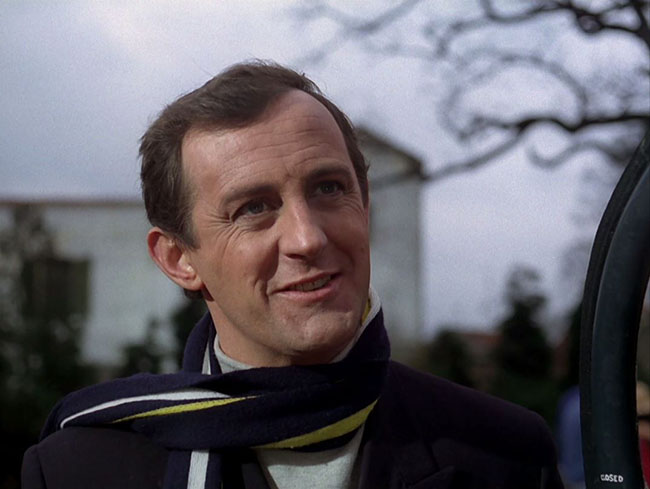
Anton Rodgers as No.2.
OBSERVATIONS
The “Schizoid Man” script is by novelist and prolific television writer Terence Feely, who also wrote for The Saint, UFO, and The Avengers, and was the creator of the series The Gentle Touch. It is one of the most brilliant, airtight, and thoroughly conceived episodes of The Prisoner. There is a moment early on when No.6 is confronted by his double for the first time, and after a few minutes one almost has to take a time-out to process it all: No.6 trying to prove his own identity, the double acting just as put out to have to prove that he is No.6, and No.2 now treating the double as the impostor – now that the double is in the room, because before that, he had to act like No.6 was No.12, you see? Writing about this episode is like trying to do a play-by-play of a shell game. There is only one cheat, or should I say concession to the poor viewer who has to keep it all straight: the double/No.12/Curtis is wearing a white jacket for the first half of the episode, a perfect negative image of No.6. So you know at all times the real No.6 – but this might have been unnecessary, given how stupendous McGoohan’s performance is. He plays the two men as two different sides of the Prisoner that we have seen before: the arrogant, self-confident, and sardonic man (Curtis), and the man on the brink, harried by malevolent forces (No.6). They are both the same person, but the latter gains our sympathy, which pulls us along through this labyrinthine episode. By the end, they dress in similar clothes but we can tell them apart with ease. In another time, McGoohan would have won an award for this performance.
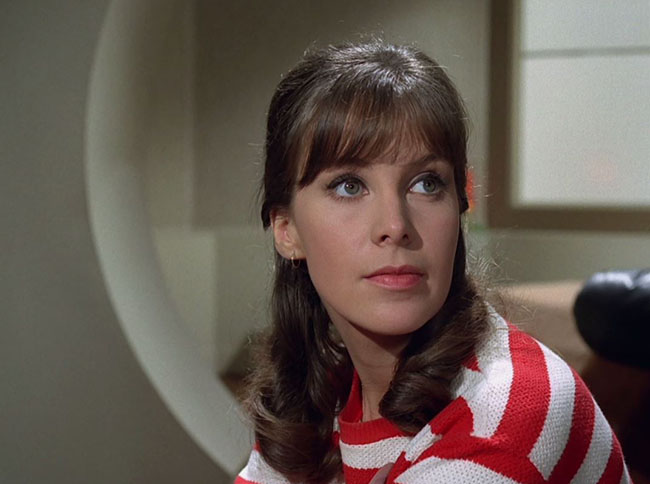
Jane Merrow as Alison, No.24.
In the script, the other man is called DOUBLE, which makes the fact that he’s No.12 a cheeky little joke: he is literally the double of 6. Toward the end, we get a few tantalizing hints of his life: a photo of a woman named Susan, the fact that he’s been through “many scrapes” with Rodgers’ No.2 before. We also learn that the scheme of this episode did not originate from No.2 but from someone (or -thing) else, if not No.1 then possibly “the General.” Either possibility should intrigue Prisoner fans. The General appears to be a reference to the episode of the same name; we’ll soon find out a lot more about this character. But if it came from No.1…well, we’ll save that kind of discussion for when we get to “Fall Out.” Of note – and clear as day on a second viewing – is that No.6 is doomed before No.2 asks to send Susan his regards. While riding the mini-moke to the helipad, he notices No.6 slipping up and saying that he’ll “report to the General,” a phrasing that (as we’ll learn) doesn’t make sense. “Report to the General?” No.2 says. “That’s a new one.” Right after that, he lays the trap with this line: “I remember Susan saying only a month ago that you’re generally quite unflappable.”
Alison is played by Jane Merrow, who was one of the few to have positive things to say about McGoohan’s on-set presence in the documentary Don’t Knock Yourself Out. The fact that her character introduces the concept of telepathy into the world of The Prisoner is just as surprising as the fact that No.6 is a believer. At the start of “The Schizoid Man,” she says, “Nobody else believed in me.” He answers, “They have no imagination.” I would have assumed that No.6 would be a staunch skeptic, but there he is, holding up the cards while she correctly guesses “a circle,” “a square,” and so on. (For the comedy version of this scene, go watch Ghostbusters.) The revelation at the end that Alison is actually another Village agent working against No.6 puts a damper on this – it’s all just a set-up so she can later match against 6’s double. But the door is left ajar on this subject when No.6 visits her in her home one last time, and she seems to “sense” that he is not Curtis. I’ve mentioned before that The Prisoner uses psychology as a theme, but “The Schizoid Man” ventures into parapsychology.
Peter Swanwick’s Supervisor is absent this episode. He’s replaced by Earl Cameron (Thunderball, Inception) in the Control Room, a Haitian who has one wince-inducing line, “In Haiti we would say he has stolen his soul!”
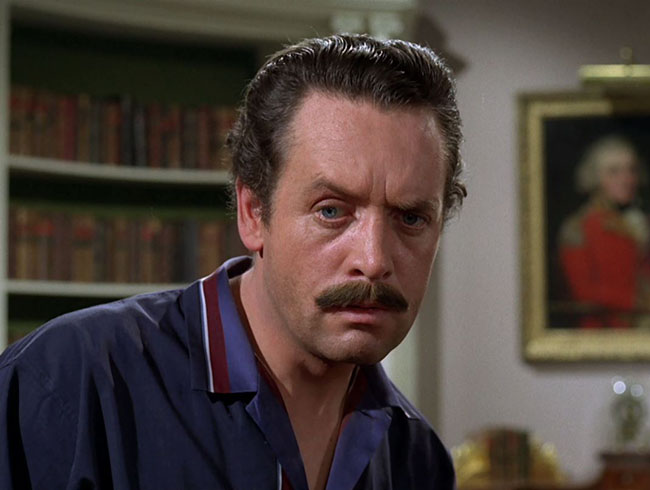
No.6 awakens with some unusual overnight hair growth.
METHODOLOGY
In arranging these episodes as I have, there aren’t many sincere efforts to find out why No.6 resigned in the early going. Despite the question coming up in “Arrival,” it isn’t asked in earnest; in “Checkmate” the Village simply wants to teach him that he can’t escape, and in “Free for All” and “Dance of the Dead” the goal is to break down his will and sense of self. “The Schizoid Man” is also an assault on his “self”; but the endgame is learning why he resigned. No.6 knows it, and uses that to bait Curtis. Like “The Chimes of Big Ben,” this is an extremely elaborate plot, but one that leans on science fiction elements. We never learn how Curtis came to look like No.6. We only know that he’s not a clone. We have to accept the premise as it’s given, and fill in the blanks as we may.
THE VILLAGE
In this episode we are introduced to the Recreation Hall, which is essentially the Village YMCA. A sign posted on the door can only be read if you freeze-frame; it advertises, “Concert of folk music to be held in the Concert Hall on Wed. Aug. 15th at 7:30. Tickets available at information desk.” That’s six months away! Must be some concert.
ROVER
Rover can’t tell the two McGoohans apart, but he’s a pretty feral guard dog, and kills Curtis rather than incapacitating him. You won’t see Rover quite as hostile again.
FISTICUFFS
After a few episodes without fisticuffs, I am pleased to announce that fisticuffs are back – and how! As No.6 walks down the Village path after curfew, some random thugs are dropped off in a mini-moke. No.6 is asked for the password, but he gives the wrong one: “Gemini.” They fight to the same musical theme that accompanies all these fights. Later, No.6 gets in a tussle with Curtis, finally conquering him and regaining his identity.
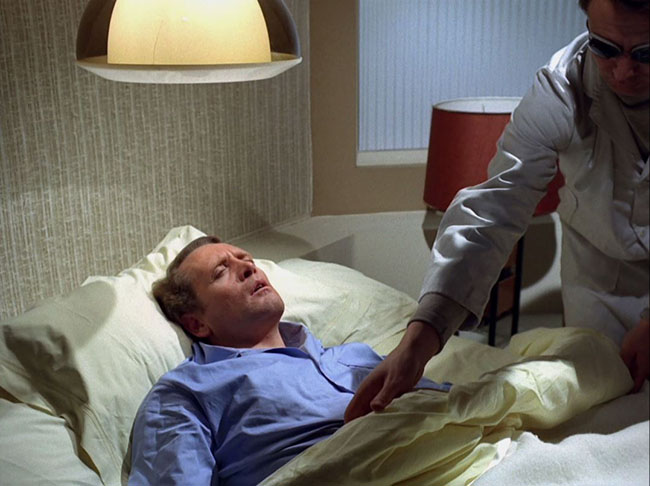
No.6 is conditioned to become No.12.
SEQUENCE
This episode and “Many Happy Returns” are rare in that the events are tied specifically to dates. We know that No.6 begins his torturous therapy to become No.12 on the tenth of February, and an indeterminate amount of time passes before he emerges in his new identity. “Many Happy Returns” begins sometime in late February, so to place them back to back makes sense. It should also come before “The General,” since the character of the General is referenced in this episode, and certainly wouldn’t be appearing in any episodes after “The General” (ahem). Although I could move other episodes into this slot, I tend to fall back on production order when there are no other clues available. This episode was the seventh to be filmed, after “Once Upon a Time,” which ultimately became the first part of the two-part series finale. So, leaving OUAT out of it, “The Schizoid Man” is the next one to step up to the plate.
6 OF 1…
No.6 is placed in the amusing position of having to explain that he is No.6, even though he’s, you know, not a number. For a while he negotiates this problem by saying “your Number Six,” as when he removes his badge and says, “I shan’t need this to remind me that I’m your Number Six.” But as the episode progresses, he is genuinely rattled by his repeated failure to prove his identity. (Another clue that Curtis is not really No.6 – he proudly wears his badge.)
WIN OR LOSE?
This is a loss, but only by a hair. No.6 is beginning to learn how to outwit his warders, though his bluffing in the last act is far too clumsy to get him out the gate. We’re very close to seeing No.6 rack up some wins against the Village…but not just yet.
QUOTES
No.6: I am the original. He is the economy pack.
The Double, after winning some competitions against No.6: Your safest bet would be battle axes in a very dark cellar.
UP NEXT: MANY HAPPY RETURNS
